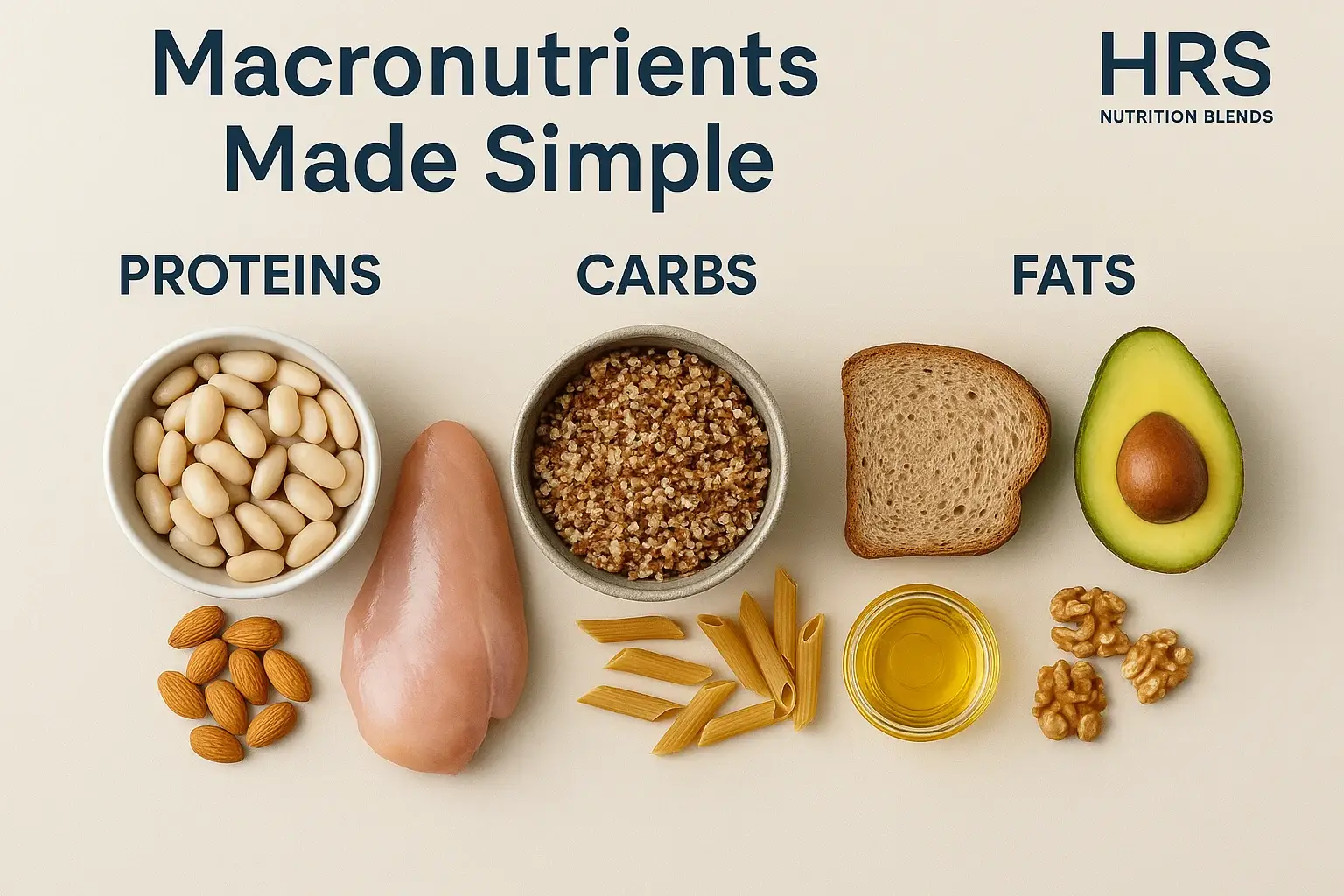Introduction
Struggling to understand how to fuel your body for energy, muscle growth, or weight balance? This macronutrients guide simplifies proteins, carbohydrates, and fats, making it easy to incorporate them into your daily diet. Whether you’re new to nutrition or refining your habits, this guide offers clear insights into macronutrient balance for a healthy lifestyle.
Macronutrients are the backbone of a healthy diet, providing energy and supporting vital functions like muscle repair, brain health, and hormone production. This macronutrients guide explains their roles, sources, and how to balance them for your goals, whether you’re aiming for fitness, weight management, or overall wellness. By following this macronutrients guide, you can make informed food choices that align with your needs, from busy professionals to active students.
For foundational nutrition, see What Your Body Needs Every Day to Stay Healthy and Energized. To plan your meals, download the Nutrition Checklist for a structured approach.
What Are Macronutrients
Macronutrients are nutrients your body needs in large amounts to function effectively, unlike micronutrients, which are required in smaller quantities. This macronutrients guide covers three key macronutrients: proteins, carbohydrates, and fats, each playing a unique role in energy, muscle building, and overall health. Proteins repair tissues, carbohydrates fuel daily activities, and fats support cell health and nutrient absorption.
Understanding these roles is central to this macronutrients guide. For example, a balanced meal with rice, dal, and ghee provides all three macronutrients, ensuring sustained energy and satiety. By mastering macronutrient balance, you can optimize your diet for fitness, weight control, or general wellness. For micronutrient insights, explore Micronutrients Explained in Simple Terms.
Proteins Building Blocks
Proteins are essential for muscle repair, enzyme production, and immune function in this macronutrients guide. Made of amino acids, they’re critical for growth, recovery, and maintaining muscle mass, especially for those with active lifestyles or fitness goals.
Protein Sources
- Animal-based: Chicken, fish, eggs, dairy (curd, paneer).
- Plant-based: Lentils (moong, masoor), chickpeas, tofu, nuts, sprouts.
Combining plant sources like rice and beans creates a complete protein, vital for vegetarians. The Harvard T.H. Chan School of Public Health recommends diverse protein sources to ensure a balanced diet. For example, a bowl of dal with roti or a paneer sabzi provides 7–15 grams of protein per serving, supporting muscle building nutrients.
How Much Protein
Aim for 0.8–1.2 grams of protein per kilogram of body weight daily, depending on activity level. For a 60-kg person, that’s 48–72 grams daily, achievable with three protein-rich meals. For precision, use the Protein Requirement Tool to calculate your needs. This macronutrients guide suggests including protein in every meal, such as eggs for breakfast or lentils for lunch, to support muscle repair and satiety.
Protein in Indian Diets
Indian diets are rich in protein options, making it easy to meet daily needs. A vegetarian thali with dal, paneer, and curd or a non-vegetarian meal with chicken curry provides ample protein. Pairing these with whole grains enhances nutrient absorption, a key aspect of this macronutrients guide. For meal timing tips to maximize protein benefits, see Meal Timing for Energy and Better Digestion.

Carbohydrates Energy Source
Carbohydrates are your body’s primary energy source in this macronutrients guide, fueling brain function, physical activity, and daily tasks. They’re essential for maintaining energy from macros, preventing fatigue, and supporting mental clarity.
Types of Carbohydrates
- Simple Carbohydrates: Found in fruits (bananas, mangoes) and milk, these provide quick energy but may cause blood sugar spikes if consumed alone.
- Complex Carbohydrates: Found in whole grains (brown rice, oats, millets like jowar and bajra), vegetables (sweet potatoes, carrots), and legumes, these release energy slowly, supporting sustained energy levels.
This macronutrients guide emphasizes complex carbs for their fiber and nutrient content, which align with healthy eating timing. For example, a breakfast of vegetable poha or millet porridge provides steady energy without the crash of refined carbs like white bread. To optimize carb intake, pair them with protein or fat, such as roti with dal or oats with curd, to stabilize blood sugar.
How Much Carbohydrates
Carbohydrates should make up 45–65% of your daily calories, depending on activity level. For a 2000-calorie diet, that’s 225–325 grams of carbs daily, achievable with meals like brown rice with sabzi or whole wheat roti. This macronutrients guide recommends focusing on whole grains and vegetables to maximize nutrient density. For timing strategies, see Meal Timing for Energy and Better Digestion.
Carbohydrates in Indian Diets
Indian staples like brown rice, millets, and whole wheat roti are excellent carb sources, rich in fiber and nutrients. A typical lunch of rice, dal, and vegetables provides a balanced carb intake, supporting energy from macros. Avoid over-reliance on refined carbs like white rice or sugary snacks, which can lead to energy crashes. This macronutrients guide encourages incorporating diverse carb sources to maintain steady energy throughout the day.
Fats Essential for Health
Fats provide concentrated energy and support cell growth, hormone production, and nutrient absorption in this macronutrients guide. They’re crucial for brain health, joint mobility, and absorbing fat-soluble vitamins (A, D, E, K), making them a vital part of a healthy diet.
Types of Fats
- Unsaturated Fats: Found in olive oil, avocados, nuts (almonds, walnuts), and seeds (flaxseeds, chia), these are heart-healthy and reduce inflammation.
- Saturated Fats: Found in butter, ghee, and red meat, these should be consumed in moderation.
- Trans Fats: Found in processed foods like packaged snacks, these should be avoided due to their negative health impacts.
This macronutrients guide emphasizes healthy fats like those in fish, nuts, and seeds. For example, adding a teaspoon of ghee to dal or sprinkling chia seeds on curd enhances flavor and nutrient absorption. Aim for 20–35% of daily calories from fats, such as 44–78 grams for a 2000-calorie diet.
Fats in Indian Diets
Indian cooking often incorporates healthy fats like ghee and coconut oil, which are rich in flavor and nutrients when used sparingly. A handful of almonds or a drizzle of olive oil on a salad provides heart-healthy fats, aligning with this macronutrients guide. For a visual guide to balancing fats with other nutrients, check the Macros vs Micros Infographic.

Balancing Macronutrients
Balancing macronutrients is key to achieving your health goals, whether it’s weight management, muscle gain, or general wellness. This macronutrients guide provides general ratios to guide your meal planning:
| Goal | Carbohydrates | Protein | Fats |
|---|---|---|---|
| General Health | 45–65% | 10–35% | 20–35% |
| Weight Loss | 40–50% | 25–35% | 20–30% |
| Muscle Gain | 50–60% | 20–30% | 15–25% |
For example, a 2000-calorie diet for general health might include 900–1300 calories from carbs (225–325 grams), 200–700 calories from protein (50–175 grams), and 400–700 calories from fats (44–78 grams). Adjust these ratios based on your needs using the BMR Calculator to determine your calorie requirements. For visual portion guidance, explore the Balanced Plate Visual Guide.
Personalizing Your Macro Ratios
Your ideal macro ratio depends on factors like age, activity level, and health goals. For instance, athletes may need higher protein (1.2–2.0 g/kg body weight) for muscle building nutrients, while those aiming for weight loss might reduce carbs slightly. This macronutrients guide suggests starting with the general health ratio and adjusting based on how your body responds. Use the Nutrition Checklist to track your macro intake and ensure balance.
Practical Tips for Balancing Macros
- Plan Meals Ahead: Use the Meal Planning Templates to structure your daily meals with balanced macros.
- Portion Control: Divide your plate into thirds: one-third carbs (rice, roti), one-third protein (dal, chicken), and one-third vegetables with a small amount of fat (ghee, nuts).
- Mix Food Groups: Combine carbs, protein, and fats in each meal, like quinoa with chicken and avocado, to stabilize energy and enhance satiety.
- Monitor Hunger Cues: Adjust portions if you feel hungry or sluggish, ensuring your daily meal plan aligns with your energy needs.
Common Mistakes with Macronutrients
Even with this macronutrients guide, common mistakes can derail your efforts. Here are pitfalls to avoid and better alternatives:
| Mistake | Better Option |
|---|---|
| Overloading Protein | Limit to 0.8–1.2 g/kg body weight to avoid kidney strain |
| Avoiding Carbohydrates | Include complex carbs like brown rice for energy from macros |
| Fearing Healthy Fats | Use olive oil or nuts for heart health and nutrient absorption |
| Ignoring Portion Sizes | Follow plate visuals from the Balanced Plate Visual Guide |
| Eating Unbalanced Meals | Combine all macros in each meal for balance |
Additional Pitfalls to Avoid
- Over-Reliance on Processed Foods: Packaged snacks like biscuits are high in trans fats and refined carbs. Choose whole foods like roasted chana or fruits, as suggested in this macronutrients guide.
- Skipping Meals: Missing meals disrupts energy from macros and leads to overeating. Stick to a daily meal plan with regular intervals.
- Neglecting Variety: Eating the same foods daily limits nutrient diversity. Rotate sources like millets, lentils, and nuts for a balanced diet.
For more on avoiding dietary errors, see How to Build a Perfectly Balanced Plate for Everyday Nutrition.
Sample Meal Plans
This macronutrients guide includes a detailed sample daily meal plan tailored to Indian dietary preferences, ensuring a balance of proteins, carbs, and fats:
| Meal Time | Food | Macros |
|---|---|---|
| Breakfast (7:30 AM) | Oatmeal with berries and chia seeds, boiled egg | Carbs (oats, berries), Protein (egg), Fats (chia) |
| Mid-Morning (10:30 AM) | Handful of almonds, banana | Carbs (banana), Fats (almonds), Protein (trace) |
| Lunch (1:00 PM) | Quinoa, grilled chicken, avocado, mixed vegetables | Carbs (quinoa, veggies), Protein (chicken), Fats (avocado) |
| Afternoon Snack (4:30 PM) | Roasted chana, herbal tea | Protein (chana), Carbs (trace), Fats (minimal) |
| Dinner (7:30 PM) | Salmon, sweet potato, broccoli, side salad with olive oil | Protein (salmon), Carbs (sweet potato), Fats (olive oil) |
Breakfast Example
Start your day with oatmeal mixed with berries and chia seeds, paired with a boiled egg. This provides complex carbs for energy, protein for muscle repair, and healthy fats for satiety, aligning with this macronutrients guide.
Mid-Morning Snack
A handful of almonds and a banana offers quick carbs for energy and healthy fats to curb hunger. This snack supports energy from macros without overloading calories.
Lunch Example
A lunch of quinoa, grilled chicken, avocado, and mixed vegetables delivers a balanced mix of carbs, protein, and fats. Quinoa provides fiber-rich carbs, chicken offers protein, and avocado adds healthy fats, making it a cornerstone of this macronutrients guide.
Afternoon Snack
Roasted chana and herbal tea provide a protein-rich snack with minimal carbs and fats, keeping you energized without bloating. This aligns with healthy eating timing principles.
Dinner Example
A dinner of salmon, sweet potato, broccoli, and a side salad with olive oil ensures a light yet nutrient-dense meal. Salmon provides protein and omega-3 fats, sweet potato offers complex carbs, and olive oil adds healthy fats, supporting this macronutrients guide.

Tracking Your Macros
Tracking your macronutrient intake ensures you meet your health goals. This macronutrients guide recommends using apps like MyFitnessPal or a food diary to log meals and monitor macro ratios. For a structured approach, download the Nutrition Checklist to track daily intake of proteins, carbs, and fats.
How to Track Effectively
- Log Meals Daily: Record what you eat, noting portion sizes (e.g., 1 cup rice, 100g chicken).
- Calculate Ratios: Use the BMR Calculator to estimate calorie needs and adjust macro percentages accordingly.
- Review Weekly: Check your logs to identify patterns, such as low protein intake, and adjust your daily meal plan.
- Use Visual Guides: Refer to the Macros vs Micros Infographic for a quick reference on balancing nutrients.
Tracking helps you stay consistent with this macronutrients guide, ensuring you achieve energy, muscle, and weight balance. For additional tips, explore What Your Body Needs Every Day to Stay Healthy and Energized.
Common Questions Answered
1. What is a macronutrients guide?
This macronutrients guide explains proteins, carbs, and fats, their roles, and how to balance them for energy and health.
2. How much protein do I need daily?
Aim for 0.8–1.2 g/kg body weight, adjustable with the Protein Requirement Tool, as per this macronutrients guide.
3. Are carbohydrates bad for weight loss
No, complex carbs like brown rice support weight management by providing energy from macros, as outlined in this guide.
4. Which fats are considered healthy
Unsaturated fats like olive oil and avocados are best, emphasized in this macronutrients guide for heart health.
5. Can I build muscle without supplements
Yes, with balanced macro ratios and proper nutrient timing, as explained in this macronutrients guide.
6. How do I track my macro intake
Use apps like MyFitnessPal or the Nutrition Checklist for accurate tracking, per this guide.
7. What’s the best macro ratio for general health
A balanced ratio of 45–65% carbs, 10–35% protein, and 20–35% fats works for most, as suggested in this macronutrients guide.
Conclusion
This macronutrients guide simplifies proteins, carbohydrates, and fats, helping you achieve energy, muscle growth, and weight balance without complex diets. By incorporating diverse sources like lentils, whole grains, and healthy fats, you can fuel your body effectively. The sample meal plan and tracking tips make implementation straightforward, whether you’re vegetarian, active, or managing a busy schedule.
Start applying these insights today for a healthier lifestyle. Avoid common pitfalls by exploring Top 10 Nutrition Mistakes You’re Probably Making next. For a visual guide to meal planning, check the Balanced Plate Visual Guide.
Disclaimer
The information in this macronutrients guide is for general guidance only. It is not a substitute for medical advice. Consult a healthcare professional before major dietary changes, especially with conditions or pregnancy. The authors are not liable for adverse effects from following this advice.
Suggested Next Read
Top 10 Nutrition Mistakes You’re Probably Making Avoid common pitfalls in your diet.
Quick Resources
- Download PDF of Macronutrients Guide
- Subscribe for Nutrition Tips
- Explore More Nutrition Guides

I’m a passionate wellness coach with over 5 years of experience helping people build healthier lives through balanced nutrition and practical lifestyle habits. I focus on science-backed guidance, including whole foods, mindful eating, and smart protein choices, to support energy, digestion, and long-term well-being. My approach is flexible, realistic, and built on the belief that prevention is better than cure because lasting health starts with daily choices.

